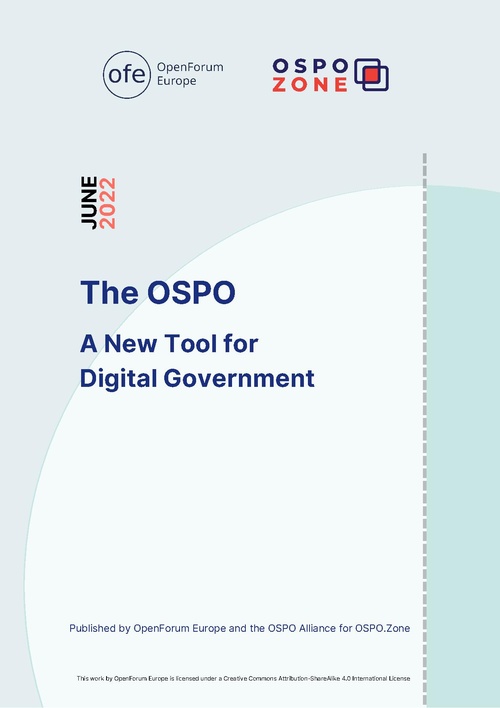The OSPO - A New Tool for Digital Government
| Report | |
|---|---|
| Image | 
|
| Published | 2022-07-01 |
| Point(s) of Contact | |
| Organization(s) | OpenForum Europe The OSPO Alliance |
| Where | Brussels Belgium |

| |
As government bodies at all levels look to better engage citizens, make more efficient use of taxpayer funds, and solve global challenges in a local context, the value of a strategic approach to Open Source software has come into sharper focus.
There is an unmistakable trend in governments at all levels (local, municipal, regional, national and supra-national) of thinking about Open Source strategically, aimed at more ambitious goals. The ubiquitous presence of Open Source in the technological landscape justifies, or even demands, a more active and horizontal approach to Open Source for most digitally-enabled public sector organisations.
As government bodies at all levels look to better engage citizens, make more efficient use of taxpayer funds, and solve global challenges in a local context, the value of a strategic approach to Open Source software has come into sharper focus. Public sector and government entities have procured, used and contributed to Open Source for decades, but the rise of the Open Source Program Office in government promises to support the public sector in best leveraging its engagement with open communities—software, standards, data, culture, research, and more.
Government CIOs and IT departments that are well-versed in Open Source are increasingly aware that the value they can realise through Open Source increases drastically when they increase their ability to participate in and contribute back to projects and the Open Source community. As a result, an increasing number of government CIOs have opted for the Open Source Programme Office as the tool to increase their organisation’s ability to meet both old and new demands.
The Open Source Programme Office (OSPO) is an institutional organisational construct that supports and accelerates the consumption, creation, and application of Open Source software. The OSPO is the centre of gravity and Open Source competence of an institution, working strategically to achieve the policy objectives of the institution that intersect with Open Source.
This paper explores early attempts to move OSPO’s into the public sector. It will discuss the evolution of Open Source in the context of governmental strategy, the value of engaging within Open Source communities, and the potential role of the OSPO in providing both the expertise and connections to manifest the value of globally networked collaboration and co-creation.
This paper takes the view of the OSPO as a multifaceted tool to solve challenges and meet demands that interact with Open Source software (OSS) facing senior executives in diverse public sector organisations across a wide array of roles. The topic is thus organisational capacity-building in the public sector.
The case studies that follow are based on interviews of OSPO leaders in the public sector, investigating why and how they built OSPOs. The case studies outline the different OSPOs’ responsibilities and activities, and look at the potential of the OSPO to achieve a series of policy goals.
The trend of building OSPOs is a response to broader trends facing the digital government. Citizens and politicians demand high quality services with more openness, accountability and accessibility. They ask for this to be met within tight budget restraints, while maintaining digital sovereignty, system resilience and cybersecurity. Open Source has a role to play across this changing landscape, and the OSPO is the government CIO’s tool to leverage OSS to meet the demands. These are complex challenges, but the OSPO is a new tool for the digital government to navigate these complexities.
The establishment of OSPOs in the private sector has been fundamental to innovating and co-creating at scale. With OSPOs, companies have figured out how to unlock vast amounts of value through Open Source, benefiting shareholders worldwide. This paper finds that the value proposition for the public sector is closely related, but fundamentally different.
The paper also looks into the mandate of the modern OSPO. It needs to provide value internally, in matters of compliance, security and governance of OSS.
Critically, the OSPO should be created with a mandate to exchange and collaborate with the external Open Source ecosystem. It needs to be an interface, supporting and managing the flows of information, ideas, software contributions, relationships and procurement between the organisation as a whole and external stakeholders.
The aim of this paper is not to outline solutions to all the different challenges and barriers facing all government CIOs, at all levels of government. Instead, the main conclusion of the paper is that OSPOs are built to give the Government CIO pragmatic options, flexibility, and control with regards to software products and services, which in turn gives them the ability to better and more efficiently meet the diverse and complex demands put on them.